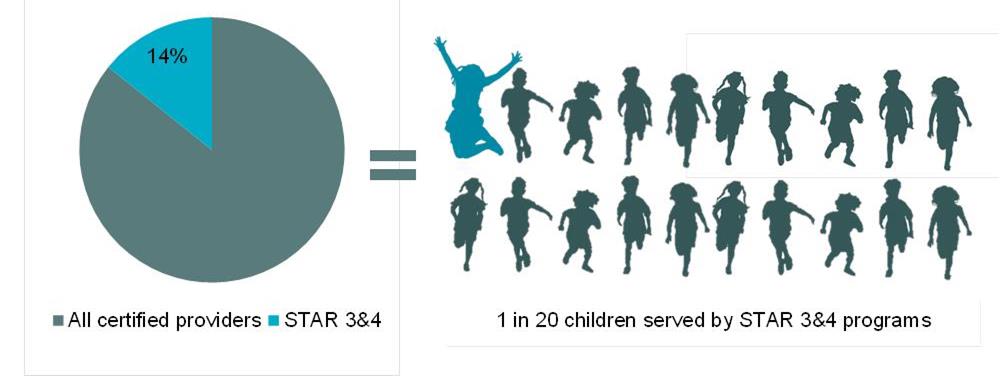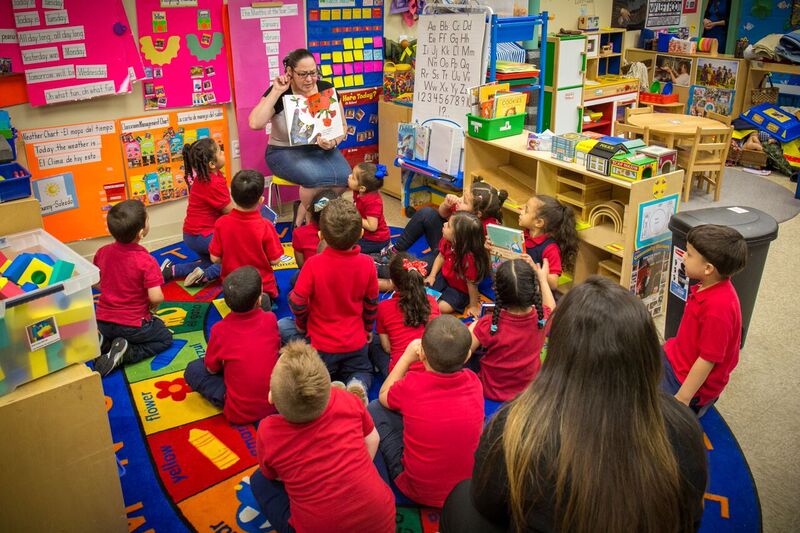By Laura Sosinsky
About 14% of certified providers in Philadelphia are considered high quality (STAR 3 or 4) and are serving about 5% of city children under 5.1 This is a fraction of the city’s unmet need for slots in high-quality centers.

How are efforts in Philadelphia working to expand the number of high-quality slots available for young children? One way is through facilities initiatives.
Early Childhood Spaces Matter for Children, Teachers, and Families
Staff and space directly translate into a center’s capacity to provide slots for children at each age group and are the two most important (and most expensive) components of a high-quality child care experience. This summer, Reinvestment Fund and Public Health Management Corporation released a new guide to provide currently operating child care providers or prospective providers in Philadelphia with information for the planning and design of high-quality early childhood spaces.
Early childhood spaces, if well designed, can encourage a child’s social, physical, language and cognitive, creative, and emotional development through play and learning in a healthy, safe, stimulating, and aesthetically pleasing environment. Space that fosters exploration through physical arrangement and child-sized furniture and materials can increase the complexity and sophistication of play and the amount of time children spend in complex play, which is how young children learn. Equipment and toys that are well-designed and thoughtfully organized can increase children’s attention spans and improve cooperative group play. Adequate quiet space with soft materials and furniture that are visually set apart may support a homier feel and increase interaction with books. Sufficient duplicates of toys and small centers encourage cooperation and discourage tussles over possession. Circulation paths can ease transitions between activities and spaces, reducing behavior problems and keeping children safe. Outdoor space has a particular importance in offering children many more opportunities for particular types of play experiences, including the most complex form of interactive peer play, more readily than the classroom.
Conversely, when problems occur over and over, the design and arrangement of the space could be part of the trouble.2 Crowding is associated with children’s attentional deficits and more time off task. Open plans are similarly associated with distraction and off-task time, plus are noisier. Noise (chronic and acute high levels) may harm children’s memory and recall, perhaps by reducing attention and ability to tune out distractions, and can contribute to cognitive development problems. Crowding and noise also correlate with a rise in cortisol (a stress hormone) over the morning period and may reduce compliance.
Crowding, noise, and other space problems might reduce the amount and quality of adult-child interactions. Teachers are the most critical element for children and are likely better able to do their jobs well in a well-designed space. High noise levels are a common teacher complaint. Teachers working in loud classrooms report greater fatigue, annoyance, and less patience, and teaching time is lost and teaching styles may be altered.
Early childhood spaces can also be designed to be friendly to families. Welcoming entrances and sufficient space for greeting and parting, security features, and planned places to organize children’s belongings, such as cubbies near the entrance, are elements that should not be forgotten in the design stages.
Of course, a center has to meet licensing and regulatory requirements. Centers are inspected by everything from the fire department to the Department of Public Health’s Office of Food Protection. Food safety, hygiene in toileting and diaper changing, prevention of the spread of germs, and support of healthy sleep and rest all start with the design of the space. Teachers need to be able to supervise children, and things like transparent barriers, low-level partitions, dividers, toilets, and sinks in the classroom can increase visibility, allow ratios to be maintained, and lessen program interruptions.
Childcare Center Design Guide: A new resource
This new guide compiles licensing and regulatory requirements established by the Pennsylvania Department of Human Services (DHS) and the City of Philadelphia as a resource to centers with plans to expand or renovate spaces in a current program, purchase and renovate existing non-childcare facilities, or design and construct a new center.
The guide also compiles best practice recommendations from three resources: the National Association for the Education of Young Children’s accreditation standards (NAEYC), the Caring for Our Children health and safety standards, and the Environment Rating Scales’ (ERS) quality indicators, which are widely used observational assessment tools including in Pennsylvania’s Keystone STARS. Among other factors, the ERS assesses how well indoor space meets the needs of children and staff as well as the arrangement of the room for play and learning. In STARS centers, Space and Furnishings scores positively correlate with assessments of children’s learning and development. In one example, ERS scores at the Jolly Toddlers center suggest how positive staff-child interactions and developmentally appropriate room arrangement and indoor space can support positive child behavior.
The guide describes the planning and predevelopment steps to consider prior to expanding or constructing a child care center, such as interviewing architects experienced in child care design and developing a project budget. The project budget should include all capital expenses, such as the cost of land, buildings, and equipment needed to bring the project to fruition, as well as noncapital start-up costs (e.g., the cost of licensing, permits, legal and architecture fees).
The takeaway? The quality of the space in a child care setting (amount of space, color, light, noise, and materials) can affect early learning, and any expansion project should consider the design elements critical to quality in early childhood spaces.
References
American Academy of Pediatrics, American Public Health Association, National Resource Center for Health and Safety in Childcare and Early Education. (2011). Caring for Our Children: National health and safety performance standards; Guidelines for early care and education programs. 3rd Edition. Elk Grove Village, IL: American Academy of Pediatrics; Washington, DC: American Public Health Association. http://cfoc.nrckids.org/WebFiles/CFOC3_updated_final.pdf
Colbert, J. (1997). Classroom design and how it influences behavior. Early Childhood News, 9(3), 22-29. http://www.earlychildhoodnews.com/earlychildhood/article_view.aspx?ArticleID=413
Evans, G. W. (2006). Child development and the physical environment. Annual Review of Psychology, 57, 423-451. https://pdfs.semanticscholar.org/a7e6/f27e919e775df2f9345dcf21e82be8790708.pdf
Harms, T., Cryer, D., & Clifford, R.M. (2006). Infant/Toddler Environment Rating Scale (ITERS): Revised Edition. New York: Teachers College Press.
Harms, T., Cryer, D., & Clifford, R.M. (2005). Early Childhood Environment Rating Scale (ECERS): Revised Edition. New York: Teachers College Press, 2005.
Helburn, S. W., & Howes, C. (1996). Child care cost and quality. The future of children, 62-82. https://www.princeton.edu/futureofchildren/publications/docs/06_02_03.pdf
Hirsh-Pasek, K., & Golinkoff, R. M. (2008). Why play= learning. Encyclopedia on early childhood development, 1-7. http://www.child-encyclopedia.com/sites/default/files/textes-experts/en/774/why-play-learning.pdf
Li, J., Hestenes, L. L., & Wang, Y. C. (2016). Links between preschool children’s social skills and observed pretend play in outdoor childcare environments. Early Childhood Education Journal, 44(1), 61-68. https://link.springer.com/article/10.1007/s10643-014-0673-2
NAEYC Early Childhood Program Standards and Accreditation Criteria: The Mark of Quality in Early Childhood Education. (2005). Washington, DC. https://www.naeyc.org/academy/standardsandcriteria
Office of Child Development and Early Learning (OCDEL). (2017). Program Reach and Risk Assessment, State Fiscal Year 2015-16, April 2017. Pennsylvania Office of Child Development and Early Learning, Commonwealth of Pennsylvania Department of Education and Department of Human Services, Harrisburg, PA. http://www.pakeys.org/uploadedContent/Docs/Reach%20and%20Risk/Reach%20and%20Risk%202015-16%20FINAL%2004032017.pdf
Schrecker, B., Norton, M.H., and Goldstein, I. (2017). Estimating Changes in the Supply of and Demand for Child Care in Philadelphia. Policy Solutions at Reinvestment Fund, Philadelphia, PA. https://www.reinvestment.com/childcaremap/pdfs/Reinvestment%20Fund%20-%20Estimating%20Changes%20in%20the%20Supply.pdf
Shim, S. Y., Herwig, J. E., & Shelley, M. (2001). Preschoolers' play behaviors with peers in classroom and playground settings. Journal of Research in Childhood Education, 15(2), 149-163. http://www.tandfonline.com/doi/abs/10.1080/02568540109594956
Singer, D. G., Golinkoff, R. M., & Hirsh-Pasek, K. (Eds.). (2006). Play= Learning: How play motivates and enhances children's cognitive and social-emotional growth. Oxford University Press.
Sirinides, P., Fantuzzo, J., LeBoeuf, W., Barghaus, K., & Fink, R. (2015). An inquiry into Pennsylvania's Keystone STARS. Philadelphia, PA: Consortium for Policy Research in Education.
Trancik, A. M., & Evans, G. W. (1995). Spaces fit for children: Competency in the design of daycare center environments. Children's Environments, 311-319. https://pdfs.semanticscholar.org/a7e6/f27e919e775df2f9345dcf21e82be8790708.pdf
1 The maximum potential supply of seats, if every city center were to enroll to its occupancy capacity, is 14,637 (20.9% of all certified seats, and 14.5% of all seats). An OCDEL report from June 2017 indicates 10,362 children are in STAR 3 and 4 centers. However, occupancy capacity is not the same as enrollment capacity, which may depend on other factors like staffing levels. “Maximum capacity” means the total number of children that the facility is permitted to serve, as specified on the license. The maximum capacity is determined by the square footage, showers, sinks, and toilets and protects from overcrowding, and ensures that the number of children served in the facility does not exceed toilet, bathing or hand-washing facilities necessary to maintain sanitary conditions. “Enrollment capacity” means the total number of children that the center is permitted to serve to be in compliance with staff-child ratios and group size licensing regulations. If staffing levels are lower than maximum building capacity, the potential supply of seats is lower as well.
2 Better Kid Care through Penn State Cooperative Extension offers a professional development lesson, Changing Spaces, to help child care practitioners explore ways to analyze space in a child care setting, identify trouble spots, and learn ways to improve space arrangement.
